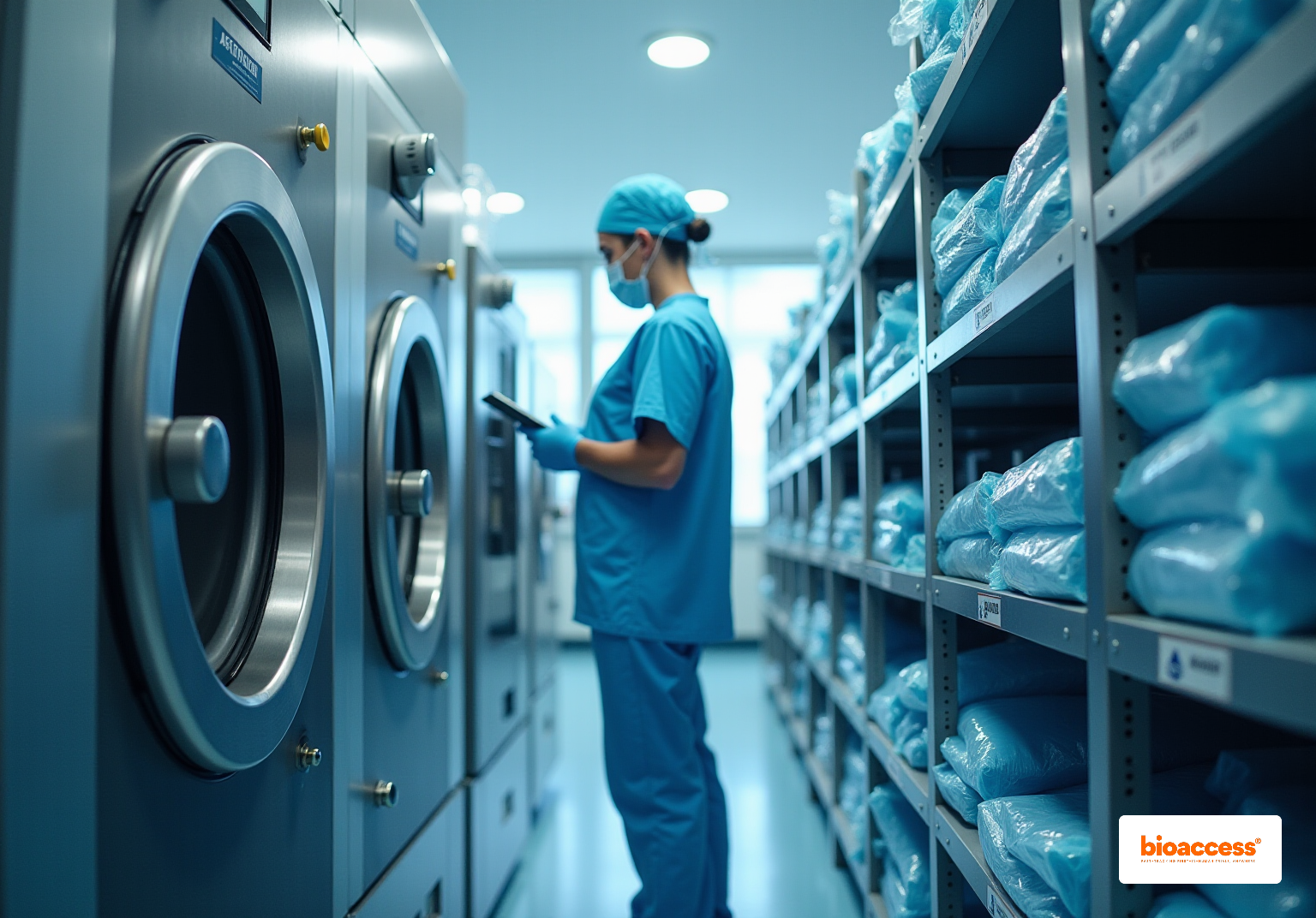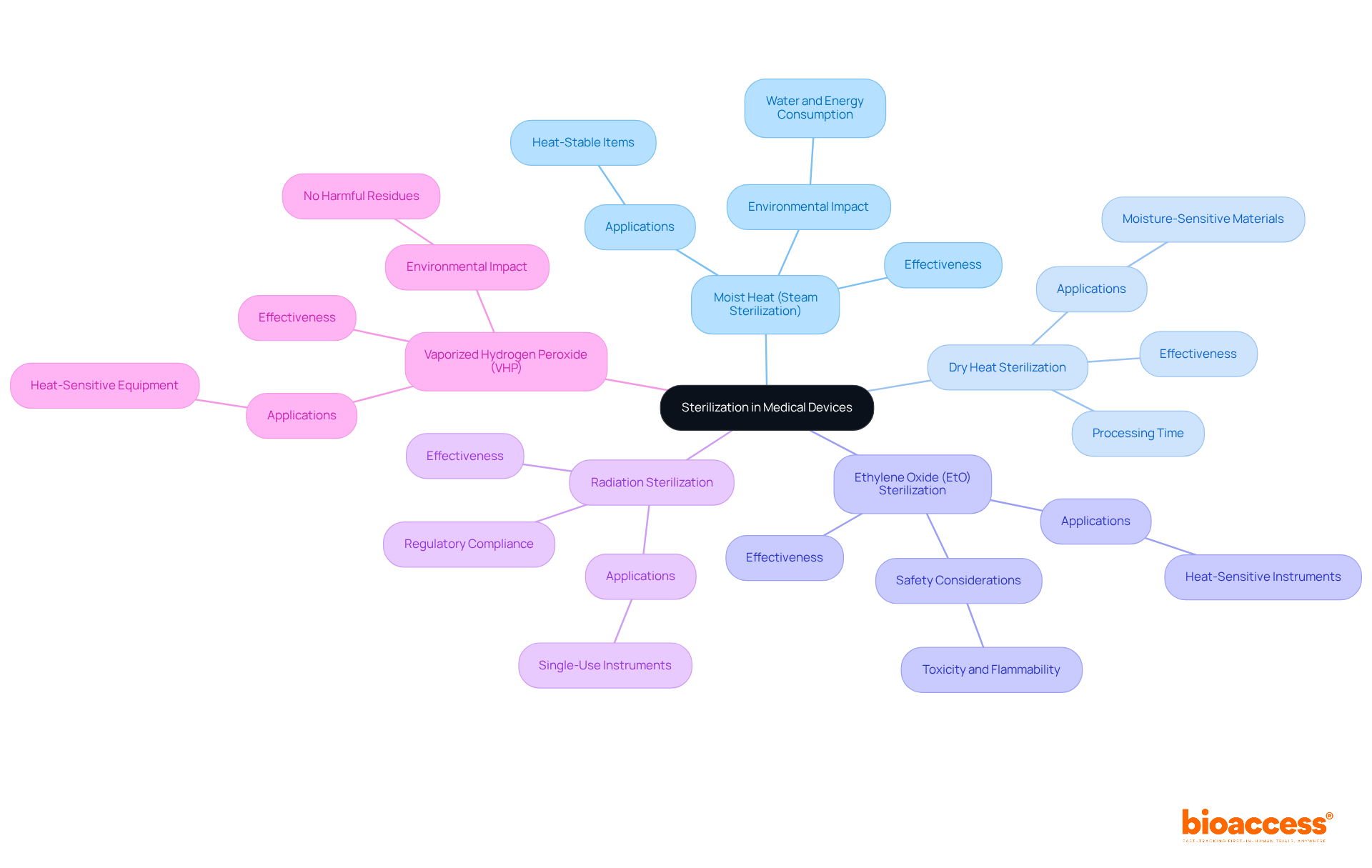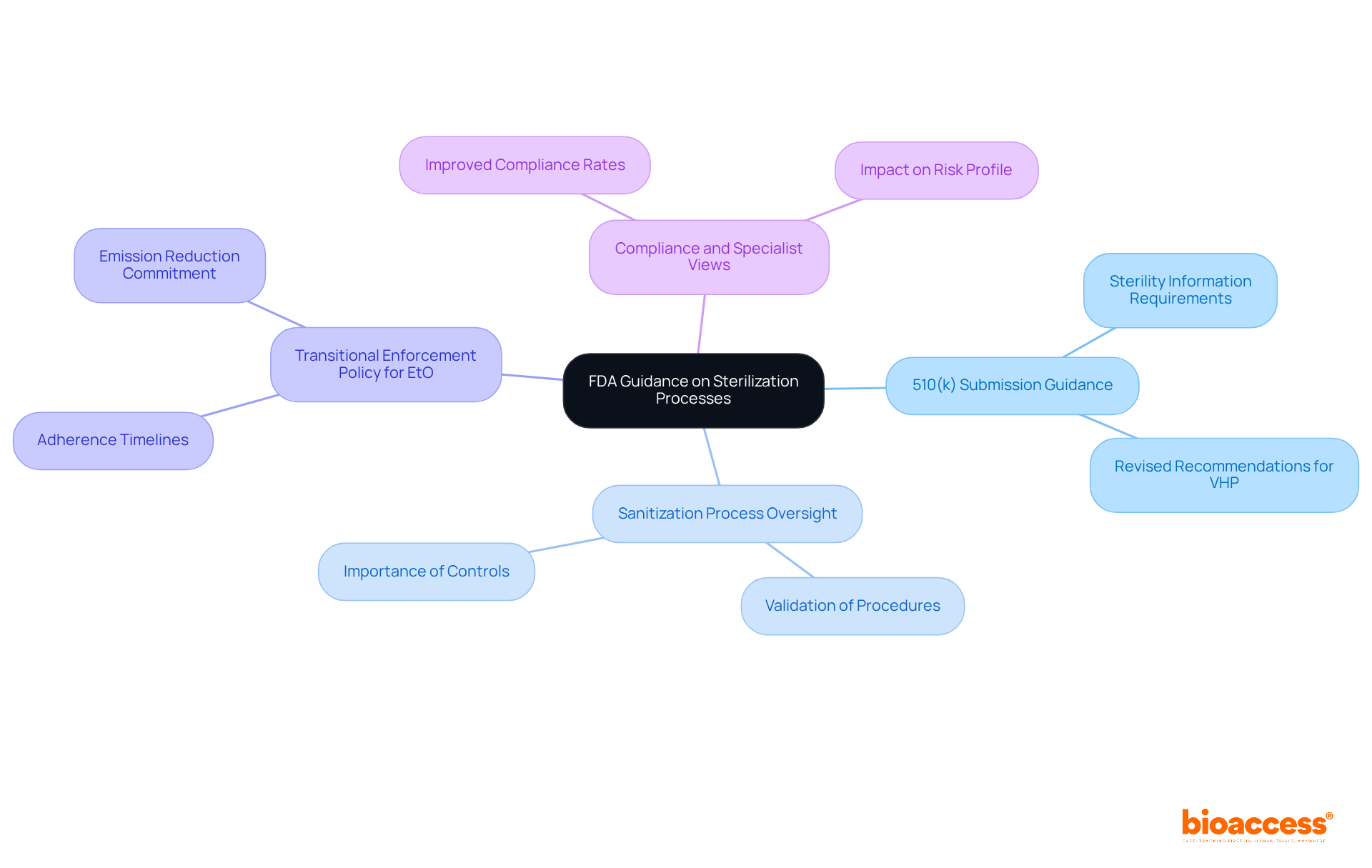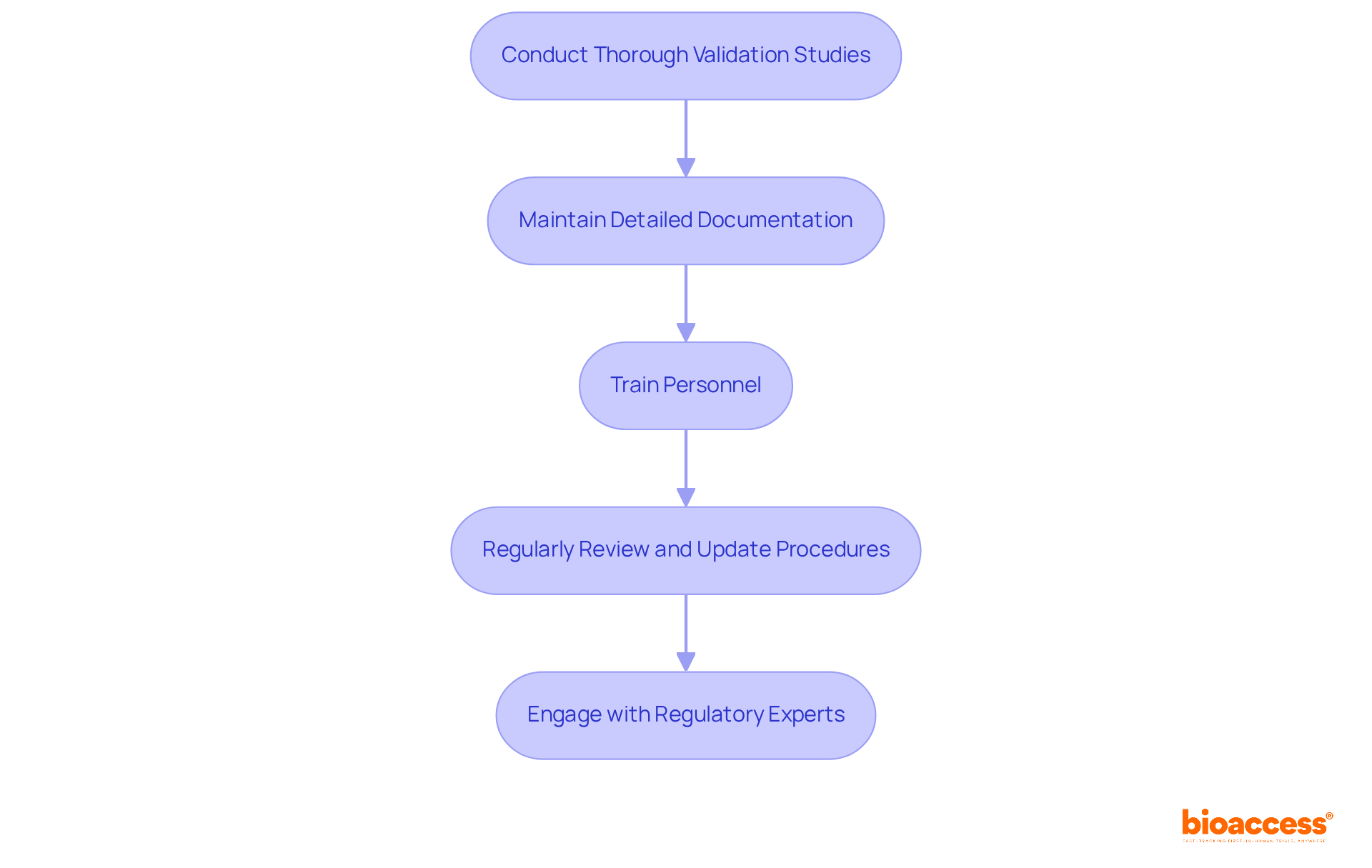


Understanding the complexities of sterilization in medical devices is crucial for ensuring patient safety and meeting regulatory standards. As healthcare facilities aim to uphold the highest benchmarks, manufacturers face the challenge of navigating a complex array of sterilization methods and FDA guidelines that dictate the effectiveness of these essential processes. What obstacles emerge when trying to balance innovation with strict compliance? Moreover, how can manufacturers guarantee that their products not only fulfill regulatory requirements but also improve patient outcomes?
In this landscape, the role of manufacturers becomes increasingly significant. They must not only comply with regulations but also innovate to enhance the safety and efficacy of medical devices. By addressing these challenges head-on, manufacturers can contribute to a healthcare environment that prioritizes patient well-being while adhering to the necessary guidelines. The intersection of compliance and innovation is where the future of medical device sterilization lies, and understanding this dynamic is vital for all stakeholders involved.
Sterilization is a critical process that eliminates all forms of microbial life, including bacteria, viruses, fungi, and spores, from medical equipment. This is vital for preventing infections and ensuring patient safety in clinical settings. Understanding the primary sterilization methods employed in the industry is essential for maintaining high standards of care.
Moist Heat (Steam Sterilization): Utilizing high-pressure steam, this method effectively kills microorganisms and is the most commonly used disinfection technique, particularly for heat-stable items. It accounts for approximately 50% of all medical devices treated in the U.S. Its reliability and cost-effectiveness make it a standard practice in healthcare environments. However, it’s crucial to recognize that steam disinfection can have negative environmental impacts due to significant water and energy consumption.
Dry Heat Sterilization: This method employs hot air devoid of moisture, making it suitable for materials that could be damaged by moisture. While it is effective, it requires longer processing times compared to steam sterilization.
Ethylene Oxide (EtO) Sterilization: This gas penetrates packaging and is effective at low temperatures, making it ideal for heat-sensitive instruments. Approximately 50% of all sterile medical instruments in the U.S. are sterilized using this method. However, it necessitates careful handling due to its toxicity and flammability. The sterilization FDA guidance oversees the validation of decontamination processes under 21 CFR Part 820, ensuring compliance with safety standards.
Radiation Sterilization: This technique uses gamma rays or electron beams to sterilize products, effectively penetrating packaging. It is particularly advantageous for single-use instruments and is known for its reliability and precise regulation.
Vaporized Hydrogen Peroxide (VHP): A newer disinfection method suitable for heat-sensitive equipment, VHP leaves no harmful residues, making it an environmentally friendly option.
Grasping these sterilization techniques is crucial for ensuring that medical instruments are safe for use in clinical environments. The importance of proper disinfection cannot be overstated; documented cases of infections from inadequately disinfected critical items highlight the necessity for stringent disinfection procedures. Adhering to established protocols and optimal methods, including compliance with ISO 13485 for regulatory approval in global markets, is essential for upholding high safety standards in the medical equipment sector.

The FDA has established thorough protocols for cleaning procedures in medical instruments, which are vital for guaranteeing security and effectiveness in clinical research. Key documents include:
Recent statistics indicate that compliance rates with sterilization FDA guidance have improved significantly, with many manufacturers successfully navigating the updated requirements. For instance, participants in the Sterility Change Master File Pilot Program, such as Steris Corporation, have demonstrated effective adaptation to these guidelines, facilitating smoother approval processes.
Specialist views emphasize the significance of following the sterilization FDA guidance, as it not only simplifies the regulatory process but also enhances the overall risk profile of medical devices. The FDA's emphasis on moving Vaporized Hydrogen Peroxide (VHP) to Established Category A further reduces the regulatory burden, allowing for faster market access while maintaining high safety standards. Staying informed about these evolving guidelines is essential for manufacturers aiming to achieve conformity and expedite their product approvals.

To ensure compliance with sterilization FDA guidance, manufacturers must adopt effective strategies that not only meet regulatory requirements but also enhance the safety and efficacy of medical products.
Conduct Thorough Validation Studies: Rigorous validation studies are essential to demonstrate the efficacy and reliability of decontamination processes. These studies should encompass various methods of disinfection, including steam, ethylene oxide, and radiation techniques, ensuring comprehensive coverage of all applicable technologies.
Maintain Detailed Documentation: Comprehensive documentation is crucial for FDA compliance. Producers must maintain detailed records of disinfection processes, validation studies, and any alterations to methods or equipment. This documentation serves as a critical reference during audits and helps ensure adherence to Good Manufacturing Practices (GMP).
Train Personnel: Adequate training for all staff involved in sanitization processes is vital. Personnel should be well-versed in the significance of adherence and the specific procedures they must follow to maintain sterility and safety in medical devices.
Manufacturers should regularly review and update their sterilization procedures in accordance with the evolving sterilization FDA guidance. This proactive strategy aids in reducing risks linked to outdated practices and guarantees continuous adherence.
Engage with Regulatory Experts: Consulting with regulatory affairs professionals can provide valuable insights into navigating complex adherence requirements. Their knowledge can assist producers in recognizing possible challenges and creating effective plans for ensuring adherence.
By applying these strategies, manufacturers can significantly improve their compliance stance, lower the risk of regulatory problems, and ensure the safety and effectiveness of their medical products.

Sterilization plays a crucial role in the clinical research and product development lifecycle of medical devices, impacting several key areas:
Device Design Considerations: The choice of sterilization methods significantly influences material selection and device architecture. Certain materials may degrade when exposed to high temperatures or specific sterilants, making it essential to consider these factors during the design phase. This is particularly important as modern devices often feature intricate designs that can hinder sterilant penetration, underscoring the need for improved design to ensure effective disinfection.
Regulatory Approval: Adhering to sanitation standards is vital for regulatory compliance, directly affecting approval timelines and market entry. The sterilization FDA guidance mandates thorough validation of sterilization procedures, requiring manufacturers to provide detailed documentation demonstrating compliance with standards like ISO 13485. In Colombia, compliance with INVIMA regulations is equally critical, as this authority oversees the marketing and production of health products, ensuring they meet safety and efficacy standards. Delays in meeting these requirements can extend time to market, impacting the product's overall success.
Clinical Trial Outcomes: Proper sterilization of equipment used in clinical trials is essential for obtaining reliable safety and efficacy data. Contaminated devices can skew results, potentially jeopardizing the approval process. For example, hospitals that implemented strict cleanliness protocols reported significant reductions in infection rates, highlighting the importance of maintaining sterility in clinical settings. Bioaccess offers comprehensive clinical trial management services, including feasibility studies, site selection, project management, and evaluation of study documents, ensuring meticulous oversight of all clinical trial elements.
Post-Market Surveillance: Continuous monitoring of disinfection procedures is crucial for regulatory compliance and addressing emerging concerns. This ongoing vigilance helps ensure that equipment remains safe for use throughout its lifecycle, as evidenced by facilities that have successfully reduced plastic waste and enhanced sterilization methods, thereby improving patient safety. Bioaccess's expertise in regulatory affairs enables manufacturers to navigate these complexities effectively, ensuring compliance with sterilization FDA guidance as well as both FDA and INVIMA standards.
By grasping these impacts, manufacturers can more adeptly navigate the intricacies of product development, ensuring their devices not only meet regulatory standards but also enhance patient outcomes.

Understanding the complexities of sterilization in medical devices is crucial for ensuring patient safety and meeting regulatory standards. This article emphasizes the necessity of mastering sterilization techniques and adhering to FDA guidance, which provides a framework for upholding high standards in medical device manufacturing. By prioritizing effective sterilization methods, manufacturers can significantly mitigate the risk of infections and enhance the overall safety of their products.
Key points discussed include various sterilization methods such as:
Each method offers unique advantages and considerations. The article also underscores the pivotal role of FDA guidelines in shaping sterilization practices, highlighting the need for:
Staying informed about evolving regulations and implementing compliance strategies are essential steps for manufacturers aiming to successfully navigate the complexities of the medical device landscape.
Ultimately, the importance of sterilization transcends mere compliance; it is a vital component of patient care and product efficacy. Manufacturers are urged to adopt best practices in sterilization and actively collaborate with regulatory experts to deepen their understanding of FDA requirements. By doing so, they can not only ensure adherence to safety standards but also contribute to improved clinical outcomes and a healthier future for patients.
What is sterilization in the context of medical devices?
Sterilization is a critical process that eliminates all forms of microbial life, including bacteria, viruses, fungi, and spores, from medical equipment, which is vital for preventing infections and ensuring patient safety in clinical settings.
What are the primary methods of sterilization used in the medical industry?
The primary methods of sterilization include Moist Heat (Steam Sterilization), Dry Heat Sterilization, Ethylene Oxide (EtO) Sterilization, Radiation Sterilization, and Vaporized Hydrogen Peroxide (VHP).
What is Moist Heat (Steam Sterilization) and its significance?
Moist Heat (Steam Sterilization) utilizes high-pressure steam to effectively kill microorganisms and is the most commonly used disinfection technique for heat-stable items, accounting for about 50% of all medical devices treated in the U.S. It is reliable and cost-effective but has environmental impacts due to water and energy consumption.
How does Dry Heat Sterilization work?
Dry Heat Sterilization employs hot air without moisture, making it suitable for materials that could be damaged by moisture. However, it requires longer processing times compared to steam sterilization.
What is Ethylene Oxide (EtO) Sterilization, and what are its considerations?
Ethylene Oxide (EtO) Sterilization uses a gas that penetrates packaging and is effective at low temperatures, making it ideal for heat-sensitive instruments. It accounts for approximately 50% of all sterile medical instruments in the U.S. but requires careful handling due to its toxicity and flammability.
Can you explain Radiation Sterilization?
Radiation Sterilization uses gamma rays or electron beams to sterilize products, effectively penetrating packaging. It is particularly advantageous for single-use instruments and is known for its reliability and precise regulation.
What is Vaporized Hydrogen Peroxide (VHP) and its benefits?
Vaporized Hydrogen Peroxide (VHP) is a newer disinfection method suitable for heat-sensitive equipment that leaves no harmful residues, making it an environmentally friendly option.
Why is understanding sterilization techniques important in healthcare?
Grasping sterilization techniques is crucial for ensuring that medical instruments are safe for use in clinical environments, as inadequate disinfection can lead to infections. Adhering to stringent disinfection procedures and compliance with safety standards is essential for patient safety.